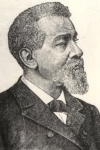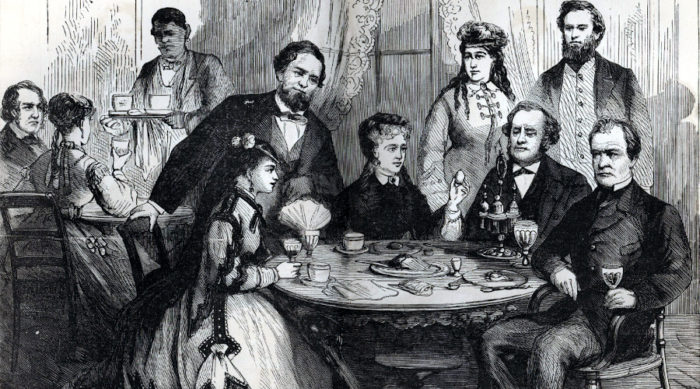
As much fun as I’ve had skimming through Ellis’s book over the last few weeks, it is also clear that his text has some important information that would otherwise have been lost. For instance, a short section on “Downing’s Restaurant” is the most cited source for information on this watering hole in the Capitol in the years after the Civil War:
This establishment occupies two rooms, and it is entered from the passage we have been traversing, and from the central corridor. It is handsomely fitted up, and is carried on for the accommodation of the members, officials, and visitors. The proprietor, Mr. George T. Downing, is a gentleman of color, of middle age, and has decidedly the most elegant manners to be seen in the Capitol. He is from New York, where he is well known to all lovers of good living, and has opened in the Capitol one of the best restaurants in the Union. His bill of fare contains every delicacy of the season, and his dishes are served in a style which would not shame Delmonico himself.
Downing [pictured above], who had been born in New York City, attended Hamilton College, then had become a well-known caterer and restaurant owner in his hometown as well as Newport, Rhode Island. He also was heavily involved in anti-slavery work.
After the Civil War, he moved to Washington, where he opened his restaurant. It was not always easy, and in 1868, he and his family were “maltreated” by employees of the Baltimore and Ohio Railroad while on their way to Washington. Fortunately, Downing had friends in high places: Charles Sumner, Senator from Massachusetts, took up Downing’s cause.
The restaurant was soon known as a place to avoid the partisanship that reigned elsewhere in the building. An 1874 Daily National Republican article called it a place to bring “unappeased and unappeasable opponents” together. During the Andrew Johnson impeachment, a picture published in Frank Leslie’s Illustrated Newspaper showed members of Congress lunching in Downing’s. The idea was to show that, in spite of the acrimony that the impeachment had created, normal life still continued behind the scenes.

Nonetheless, sometimes partisanship did rear its head in the restaurant, for instance in 1875, when Ex-Congressman James B. Sener of Virginia got into a fight with Emerson P. Brooks, at that time editor of the National Republican newspaper. Fortunately, according to the Washington correspondent of the Baltimore Sun “friends intervened and no serious injury was done.”
One of the people to haunt the restaurant was none other than famous moocher Beau Hickman, who “daily fluctuated between Downing’s Restaurant and the reception room of the Senate,” according to 1922 article in the Evening Star.
Downing did not last long, and in 1876, he was forced to sell the restaurant to a Mr. Freund. While the transfer was not entirely to Downing’s liking, he still took part in the ritual:
The ceremony of presenting the keys will be celebrated like the delivery of the keys to the King of the Carnival on Mardi Gras day. It is understood that, unless the cooks shall strike for higher wages, Mr. Freund will cook 2,673 terrapins and 8,304 quails as a free opening lunch to Congress.
Downing briefly ran the Senate restaurant before returning to Rhode Island, where he continued to fight for civil rights until his death in 1903.
